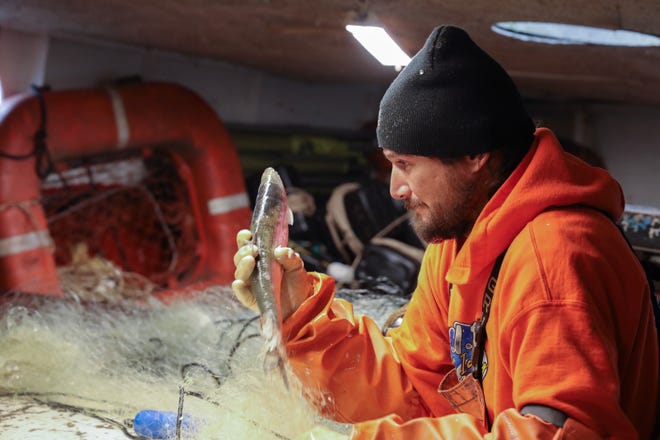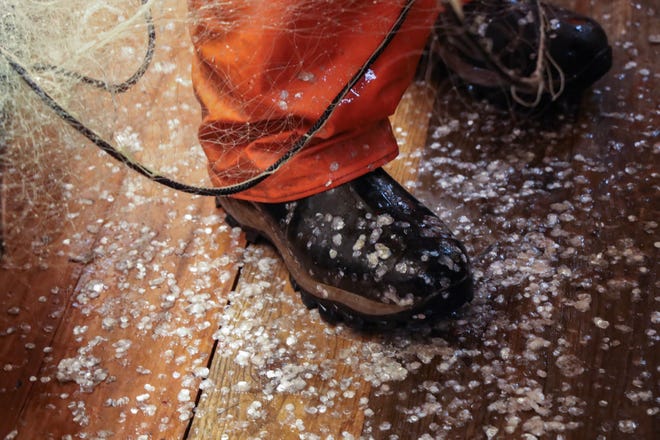Great Lakes pollution threatens Ojibwe treaty rights to fish

The ensnared fish seemed to materialize from the water. Thrashing, wriggling, they rose, enfolded by mesh.
The lift reeled the gillnet into the arms of a waiting crew, who hoisted it atop a table. Iridescent scales popped into the air like confetti as the men gripped and untangled the flopping lake herring from the net.
“When the floor is shiny with scales, we know we are making money,” said commercial fisherman Donny Livingston, grinning widely.

Shortly before dawn, the fish tug Ava June pulled out from Duffy’s Dock, on the tip of northern Wisconsin’s Bayfield Peninsula. The vessel churned through Lake Superior’s chilly waters for 2 1/2 hours before reaching nets set the previous day.
Livingston is a citizen of the Red Cliff Band of Lake Superior Chippewa, one of six federally recognized Ojibwe tribes in Wisconsin.
His family has fished for generations and holds an original license issued to Red Cliff citizens, but their access to Lake Superior fish was never a given.
Ojibwe, Ottawa and Potawatomi communities, who also call themselves Anishinaabe, have fished in the Great Lakes for centuries. But in the mid-1800s, the federal government, desiring to open the Wisconsin Territory to lumbering and mining, forcibly acquired Ojibwe lands and waters through treaties.
Tribes retained hunting, gathering and fishing rights across what’s now called the Ceded Territory: portions of three Great Lakes and millions of acres in Michigan, Wisconsin and Minnesota. The final treaty established reservations for four of the Wisconsin Ojibwe tribes.
States spent a century disregarding or rejecting treaty rights. After tribal citizens sued, several court rulings, starting in 1971, would affirm their reserved rights within the Ceded Territory, including the right to fish on Lake Superior.
But many see Great Lakes pollution as a continued encroachment on how Ojibwe communities exercise those rights.
Alongside toxic mercury and carcinogenic polychlorinated biphenyls are the latest contaminants of concern — per- and polyfluoroalkyl substances, or PFAS.
The class of more than 12,000 “forever chemicals” accumulate in the environment and humans. Scientists link two of the most widely researched PFAS — PFOA and PFOS — to a range of health problems, including cancer.
The failure of federal and state governments to keep contaminants out of the environment, scholars and environmental advocates say, calls into question their commitment to protect Indigenous rights.
“It’s a modern way of denying access and destroying foodways,” said Katrina Phillips, an associate professor of history at Macalester College and a Red Cliff citizen. “It’s through chemicals and pollutants instead of treaties and court cases.”
Fish are vital for Ojibwe communities
Livingston and his business partner, Bryan Bainbridge, teamed up a decade ago after growing up in and around Red Cliff.
The work is grueling. Profit margins, narrow. Crew, tough to find.
Livingston, 42, has tried other careers but always returned to fishing.
“It’s something I know how to do,” he said. “It’s something I can depend on.”
The Red Cliff Reservation flanks Lake Superior’s southern coastline, marked by sandstone cliffs, wetland sloughs and rivers. Coyotes, whitetail deer and bobcats roam its 15,000-plus acres. Bald eagles soar overhead and ospreys dive to prey on fish.
These relatives — the plants and animals, land and water — sustain Ojibwe communities.
Giigoonh, or fish, are important for subsistence, culture and business. But climate change threatens many species, and contaminants long polluting the Great Lakes, the health of people who eat them.
More than 7,600 people are living Red Cliff tribal citizens, about 16% of whom live on the reservation. A few hundred reside 3 miles south in Bayfield, a destination for lake-loving tourists.
The tribe is the county’s largest employer, providing about 300 jobs — many in tribal administration and the Legendary Waters Resort and Casino.
But at its heart, Red Cliff is a fishing community.
“That’s what everybody’s family has done around here,” said Bainbridge, 45, a former Red Cliff tribal chairman. “I grew up on fish.”
After decades of overfishing from the late-1800s through the 1930s and the introduction of invasive species, Lake Superior’s fish populations have rebounded enough to sustain a consumer market. Among tribally licensed commercial fishermen, whitefish, salmon, lake tout, trout and lake herring constitute the bulk of the catch.
The combined commercial fish harvest of 11 Ojibwe nations that are members of the Great Lakes Indian Fish and Wildlife Commission annually exceeds 2 million pounds.
PFAS in Great Lakes water and fish
For much of the 20th century, manufacturing plants generated mercury- and PCB-containing wastes and dumped them directly into the Great Lakes or its watershed. Power plants and incinerators also spewed pollution that tainted waters, and they continue to do so. The toxic chemicals accumulate in the water and sediments — and fish.
Their concentrations have declined significantly in Great Lakes waters since the 1970s due to efforts of the U.S. and Canadian governments, states and industry to reduce toxic emissions. Yet lingering mercury and PCBs bioaccumulate in animals at levels high enough to warrant fish consumption advisories.
PFAS also are drawing greater scrutiny as their harms come into focus. In 2021, the Wisconsin Department of Natural Resources issued Lake Superior’s first PFOS advisory, warning against eating too many smelt.
PFAS, which are added to products ranging from fabric stain protectors to firefighting foam to food packaging, enter water bodies through wastewater, airport and fire training runoff and the atmosphere.
Compared to the other Great Lakes, the concentration of PFAS in Lake Superior water is lower due to less development within its watershed. But virtually no amount of PFOA and PFOS is safe for human consumption, according to the EPA.
The impacts of such pollution and climate change create “an elevated level of environmental anxiety” in Ojibwe communities, said Dylan Bizhikiins Jennings, associate director of Northland College’s Sigurd Olson Environmental Institute and a former council member of the Bad River Band of Lake Superior Chippewa.
Anishinaabe cultures embedded in places
Edith Leoso, a retired Bad River tribal historic preservation officer, grew up on the reservation in her grandparents’ house.
When she was 8 years old, her grandmother decided to teach her to pray for the water by placing tobacco into a nearby river.
“Don’t do anything disrespectful on this water or to this water,” her grandmother told her. “Because it’ll take care of you, and everything you need is here.”
Indigenous origin stories, histories, languages and cultures are embedded in the land and water, said Phillips, the historian.
“For Ojibwe people in northern Wisconsin, Lake Superior and the northern part of Wisconsin with Red Cliff and Bad River, these places define who we are,” she said.
In accordance with their bimaadiziwin, or traditional lifeway, Ojibwe people harvest from nature as an act of stewardship. If they do not, the Creator will cease to provide those beings.
When the land and water are contaminated, future generations lose knowledge and stories centered on fishing and other harvesting. Family, kinship, oral history, ceremony, community cohesion, food security and self-determination suffer.
“Everything that makes us Native,” said Patty Loew, director of the Center for Native American and Indigenous Research at Northwestern University and a Bad River citizen.
“If the health of the fish or the wild rice is compromised,” she said, “then treaty rights are meaningless.”
EPA proposal: regulations must consider treaty rights
Court rulings that affirmed treaty rights addressed whether, where and how Ojibwe tribes could exercise them. Courts considered the quantity of natural resources but not their quality.
“It’s a legally gray area, how far the tribes can dictate what a state or the federal government might have to do or not do in order to preserve the treaty rights,” said Ann McCammon Soltis, director of the division of intergovernmental affairs at the Great Lakes Indian Fish and Wildlife Commission.
But GLIFWC’s member tribes believe states should preserve the integrity of natural resources, she said.
A recent EPA proposal could address some of those concerns.
The draft rule would compel states to account for treaty rights, such as fishing and wild rice gathering, when setting standards under the Clean Water Act. That law forces states, territories and some tribal governments to improve the quality of water bodies when they cannot safely be used for designated purposes like drinking or recreation.
States would also need to preserve full use of any resources guaranteed under the treaties on and off reservations.
Wisconsin DNR officials said the agency already consults with tribes and considers their uses of a waterbody when it sets standards. Tribes also may submit comments when states review their standards every three years.
But “the states haven’t really had to respond in any way” when the tribe presents a request, Soltis said.
“This indicates that the EPA is going to be a little bit more willing to take what the tribes say seriously.”
Red Cliff band protects sovereignty
Absent stronger state and federal action, Ojibwe communities have forged strategies to protect water, fisheries and lifeways now and for the next seven generations.
Red Cliff’s Treaty Natural Resources Division oversees the protection and enhancement of natural resources within the reservation boundaries and the band’s ceded territory. That includes stream and riverbank restoration, water and air quality monitoring, hazardous waste disposal and wild rice reseeding. An environmental justice specialist monitors outside projects including mines, pipelines and concentrated animal feeding operations that could affect treaty rights.
The tribe bolsters food sovereignty through its Red Cliff Fish Company, which opened in 2020, and 35-acre Mino Bimaadiziiwin Gitigaanin — Return to the Good Life Farm.
Red Cliff Tribal Fish Hatchery staff raise brook trout in hopes of restoring populations to past levels in Lake Superior. They also rear walleye in ponds to increase populations in inland lakes.
Practicing treaty rights might be viewed as a political act in a country with a long history of challenging them.
“Having to fight for access to food is kind of mind-boggling in a sense,” Phillips said. “Advocating for the right to feed your people is somehow seen as resistance or activism.”
This story is a product of the Mississippi River Basin Ag & Water Desk, an editorially independent reporting network based at the University of Missouri School of Journalism in partnership with Report For America and funded by the Walton Family Foundation. Wisconsin Watch is a member of the network.
You may also like
-
Mad Scientist Tackle coats Ned Head Jig with brilliant UV coatings to achieve maximum radiance
-
Playing the Short Game
-
DNR Reminds Anglers To Report Any Catches Of Round Goby In Winnebago System
-
CAD IS THIS SATURDAY! One Day Only! In-Person and Online, June 21 at St. Croix Customer Appreciation Day!
-
This Week on Outdoors Radio with Dan Small Outdoors
